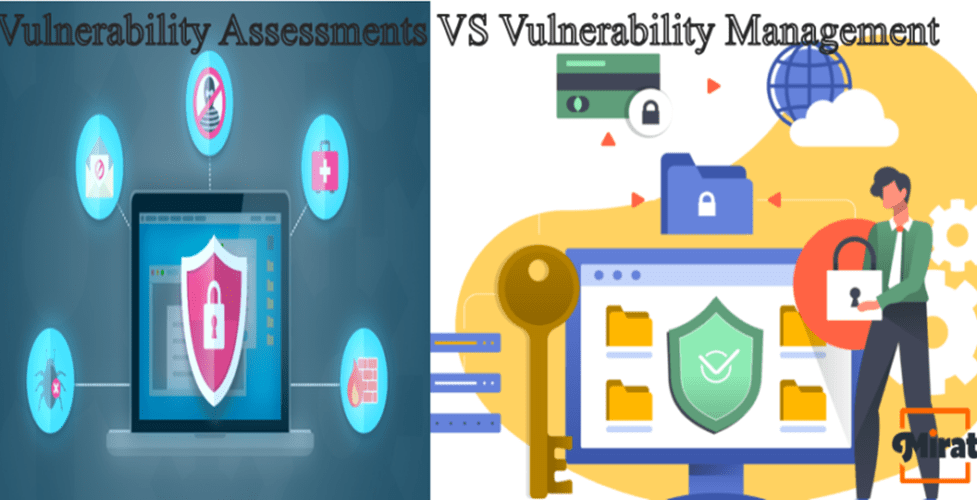Mirat.ai might not give you a percentage or exact number but sure can explain what they are individual. They are not explicitly away from each other and are interdependent.
Vulnerability Assessment is part of a Vulnerability Management system. Vulnerability assessments are likely to be repeated to refine a Vulnerability Management strategy.
Vulnerability management comprises four steps:
- Finding Weaknesses
- Analyzing Weaknesses
- Treating Weaknesses
- Victims Reporting
1) Finding Vulnerabilities
A susceptibility scanner is at the heart of most vulnerability management solutions. The scan has four stages:
- Ping or send TCP/UDP packets to network-accessible systems to scan
- Identify scanned systems’ open ports and services.
- Log in remotely to systems to get detailed system data.
- Known flaws correlated with system data.
Loops or flaws in laptops and desktops, physical and virtual servers, databases, switches manual or smart, printers, firewalls, etc., susceptibility scanners can scoop, Users’ accounts, file system structure, and system parameters are all probed for. This data is used to link scanned computers to known accountibilities. Susceptibility scanners will use accountability databases to link the publicly known susceptibilities.
Configuring amenebility scans is critical to a vulnerability management solution. It is to be accepted that, at times, accountibility scanners can also occasionally disrupt networks and processes. If an organization’s network capacity is limited during peak hours, accountability scans should be scheduled during off-peak times.
It may be necessary to exclude specific systems from susceptibility scans or to adjust the scans to be less disruptive if they become unstable or behave unpredictably. Adaptive scanning is a novel way to automate and streamline accountability scans depending on network changes. To attenuate the quickness, here is an example. If any new system or process joins the network, amenability scanners check the system as soon as possible or at that specific point of time rather than wait it out until monthly or week scheduled scans.
Scans aren’t the only approach to acquire system accountability info. In the absence of network scans, endpoint agents collect amenability data from systems. This lets firms keep track of system accountibilities whether or not employees’ laptops are connected to the company’s network or their home network.
2: Assessing Risks
After identifying accountabilities, they must be examined to determine their risks to an organization’s risk management plan. Threat and Vulnerability management solutions provide risk evaluations and scores for exposures, such as CVSS scores. These rankings help businesses prioritize amenabilities, but the actual danger caused by any specific amenability is determined by variables other than the risk ratings and scores.
Additional variables to consider while assessing vulnerabilities include:
- Is this a real or fake vulnerability?
- Is it possible to exploit this flaw via the internet?
- How hard is it to underrate this flaw?
- Is there a known exploit code for this flaw?
- What would happen if this vulnerability is taken advantage of?
- Can this vulnerability be exploited without compromising other security controls?
- The time frame of vulnerability on the network?
Mirat.ai wants you to understand that amenability scanners aren’t flawless. Their susceptibility detection false-positive rates are over zero. Validating amenabilities with penetration testing tools and procedures helps eliminate false positives, allowing organizations to focus on valid accountibilties. If organizations think their firewalls are enough to ward away threats, then a amenability validation exercise can explicitly bring forth flaws and add to the realization.
3: Treating Weaknesses
Once a vulnerability has been validated and designated a risk, it is time to prioritize its treatment with original business or network stakeholders.
There are several approaches to fix susceptibilities, and organizations should aim for this perfect treatment option.
Mitigation: Mirat.ai security vulnerability assessment modules help in reducing the risk and their impact upon exploitation. Mitigation is occasionally required when a proper remedy or patch for a accountability isn’t yet available.
Acceptance: Taking no action to repair or mitigate a vulnerability’s consequences. They usually justify this when exposure is deemed low risk and the expense of correcting it outweighs the cost of exploiting it.
Threat and Vulnerability management solutions provide fixes for amenabilities. When a remediation recommendation isn’t the best strategy to address a amenability, the security team, system owners, and administrators must decide how to proceed. Remediation can be as easy as installing a software patch or as sophisticated as rebuilding an entire network of physical servers.
After Mirat.ai completes its remediation through its modules, it will re-scan for amenabilities to ensure they are entirely fixed.
But not all flaws must be rectified. For example, if a company’s suceptibilities scanner found Adobe Flash Player vulnerabilities on their machines, but they blocked it in web browsers and other client apps, that may be termed a compensating measure.
4: Reporting flaws
Regular and continual security vulnerability assessments help firms understand their vulnerability management services’ efficiency over time. vulnerability management services often provide customizable reports and dashboards for exporting and displaying amenability scan results.
Mirat.ai’s security vulnerability assessment protocols help IT teams understand which remedial strategies can help them fix the most accountabilities with ease. Mirat.ai can also help surveillance teams monitor susceptibilities inclinations over time across the network.
Mirat.ai’s IT Infrastructure Management is Affordable & Easy to use! Get your Dashboard ready in only 5 Minutes. Request for Trial/Demo now (or) Contact our Team Now .
Contact Information:
Hema
Sales Executive
Phone: +1-315-636-4213
Email: sales@mirat.ai
Website: https://www.mirat.ai/


